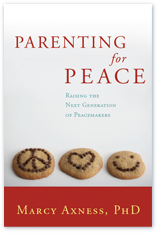Occasionally when I’m telling people about my new book, they hesitate over the notion of raising a “peacemaker.” (Don’t worry—this happens only very occasionally!) They flinch at the idea that I might be campaigning to raise a generation of wimps… peaceniks… idly sunny beings whose inertia might only allow for a round or two of “Kumbaya”—in perfect harmony, of course. No. What I mean by a peacemaker is a socially healthy human being: an intelligent person whose brain is wired with the capacity for inner balance, empathy, and enlightened social action.
And the peace I refer to is not simply the absence of violence or strife, and neither is it the stereotypical soft-focused dream scene of doves and olive branches.
This peace is a state of being vibrantly at-ease, from cell to soul, steeped in the tranquil conviction I’m a worthy participant in life… fit to meet any challenge.
Peacemaker qualities include intellectual and emotional flexibility, robust imagination and the ability to devise innovative solutions to complex puzzles. Also very important, the quality of resilience: how does the person handle daily stresses? A child who learns to readily regain internal balance after a frustrating moment becomes an adult capable of embracing peace instead of conflict. All of these capacities rely on well-developed brain centers that govern self-regulation, sensory integration and social intelligence. Someone with a well-wired brain doesn’t get overwhelmed with stress hormones, at least not for very long. They bounce back.
Peace also suggests a condition of feeling safe. It presumes a fundamental posture of security, wellbeing, and an orientation toward growth, exploration and connectedness, with self and with others. We know from the new field of interpersonal neurobiology that this experience of safety, of peace at the level of biochemistry, is something that can become woven into the very fabric of our neurophysiology.
This is the purpose of the seven Parenting for Peace steps and principles: they foster the optimal development of those brain centers and support the flourishing of the whole child—body and mind.
Tags: brain development, peace, peacemaker, social intelligence


